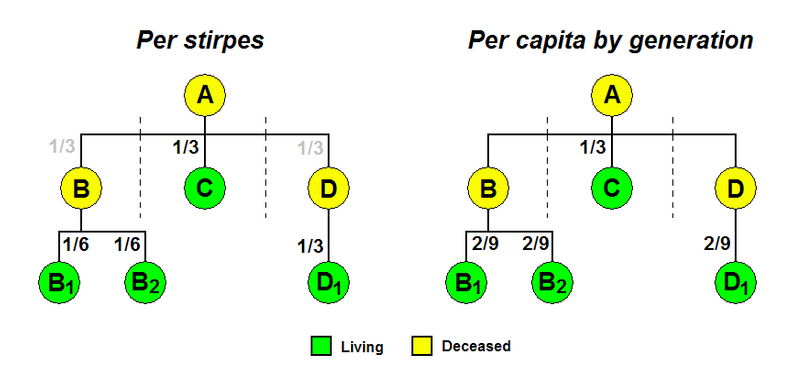Two words that can change your child’s inheritance

Knowing a little Latin can save you a lot of money. In this case, a little Latin in not a short resident of Greece, but an important legal term that you may see in your will. The term per stirpes, along with its legal cousin, per capita, refers to how an estate is passed along to the heirs. What you should remember is that one term causes the estate to follow the bloodline “branches” while the other term forces a more equalized per person distribution of the estate’s assets.
Let’s look at an example of three children who are the heirs of their parents and what happens when one child dies before the other two. Note how the money follows the branch of the family tree for the deceased child.
The father A, specifies that his estate is to be divided among his descendants in equal shares per stirpes. A has three children, B, C, and D. B is already dead, but has left two children (grandchildren of A), B1 and B2. When A‘s will is executed, under a distribution per stirpes, C and D each receive one-third of the estate, and B1 and B2 each receive one-sixth. B1 and B2 constitute one “branch” of the family, and collectively receive a share equal to the shares received by C and D as branches as shown in the diagram above.
The alternative, per capita, allows a more even division of the assets as explained below.
Per capita at each generation is an alternative way of distribution, where heirs of the same generation will each receive the same amount. The estate is divided into equal shares at the generation closest to the deceased with surviving heirs. The number of shares is equal to the number of original members either surviving or with surviving descendants. Each surviving heir of that generation gets a share. The remainder is then equally divided among the next-generation descendants of the deceased descendants in the same manner.
Here’s a chart (below) that shows the effect that the choice of these two terms can have for the family of your heirs.
Note that on the left, each branch receives one third of the estate. On the right, A‘s only surviving descendant,C, receives one third of the estate. The remaining two thirds are divided between the descendants in the next generation.
[click the chart below for a larger image]
As always, clients should check with us before any changes are made to your estate plan.

